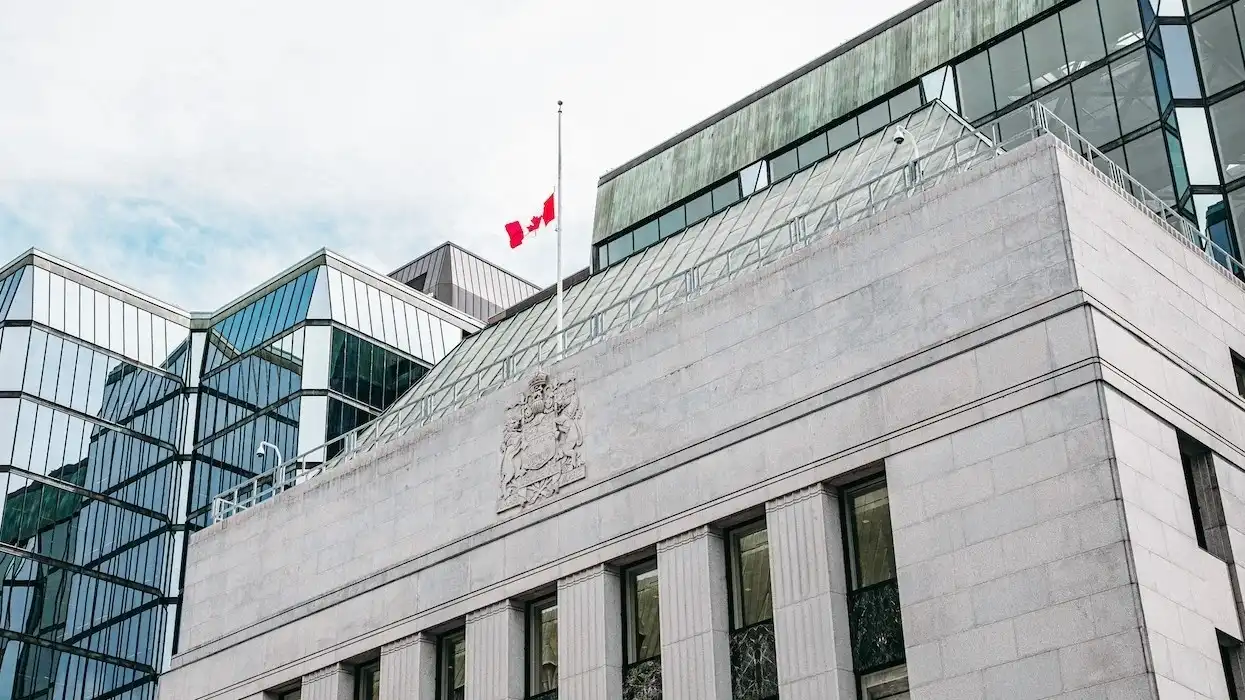UPDATE: On Wednesday morning, the Bank of Canada announced a 50 bps cut, the largest since 2020, bringing the overnight interest rate to 3.75%.
The next Bank of Canada interest rate announcement is scheduled for this week — on Wednesday, October 23 at 9:45 am — and although there’s no longer debate as to whether the central bank will hike, hold, or cut, there remains some degree of debate with respect to the size of the anticipated cut.
The past three rate announcements have culminated in a quarter-point cut each time, mind you, and those brought the policy rate from 5% to 4.25%. Meanwhile, another 25-basis-point drop is certainly on the table this week, but economists with Canada’s ‘Big Five’ banks are by and large thinking bigger as things like inflation, GDP, and employment numbers continue to swiftly soften. Here’s exactly what they’re forecasting for the second-last interest rate announcement of the year (and the announcements to follow).
TD: “Either way, rates will continue to head lower”
TD Economist James Orlando and his peers are conservatively forecasting a 25 basis points cut. Still, they say that the upcoming decision will be a “nail biter” — but either way, rates will continue to head lower,” they say. “The argument for a 25 bp cut is that there is still clear strength coming from the jobs market, with wage growth running well above inflation.”
And Orlando is speaking to the fact that, in September, the national unemployment rate dropped down to 6.5%, from 6.6% the month prior, pointing to more slack. “This will support consumer spending, which we think is starting to accelerate heading into the holiday shopping season,” according to the report. Meanwhile, on the housing market, Orlando said that it’s the “biggest beneficiary from the BoC’s easing cycle.”
“While the market response to rate cuts hasn’t come to a boil like many would have expected, it is starting to stir. Housing sales jumped nearly 2% in September and are up 6% since rate cuts started in June,” he writes. “But at the same time, listings are up over 9%, as sellers test out the market following nearly two years of housing market uncertainty. This has the sales-to-listings ratio on the decline, which has limited the potential acceleration in house price growth We expect this to give way in the coming months once the recent wave of listings has been cleared. This should jolt the housing market, pushing sales and prices higher.”
RBC: ‘A 50 bps reduction to 3.75%’
For RBC, Economist Nathan Janzen anticipates that the BoC will “accelerate the pace of interest rate cuts with a 50-basis point reduction to the overnight rate to 3.75% .”
“An underperforming Canadian economy had already pushed the BoC to lower interest rates earlier than most advanced economy central banks,” Janzen writes, citing the fact that gross domestic product grew just 0.2% at last count. “Three consecutive 25 bps cuts that began in June are already in the books,” Janzen said. “Yet, the economic backdrop has continued to soften, and risks to inflation look increasingly tilted to the downside of the BoC’s 2% target.”
RBC is additionally calling for a 50 bps cut in December and reductions down to 2% by mid next year — and that’s per their base case forecast.
CIBC: ‘Tough to argue a 75 bps cut’
Over at CIBC, the question is more of a gamble: will the BoC raise 50 bps or 75 bps? “While a mega-move isn’t our base-case forecast, there are reasons to think that Governor Macklem’s team will give such a move more consideration than the 25 basis point cut that some economists are still projecting,” writes CIBC Economist Avery Shenfeld.
“Markets have thrown down their 50 basis point chip on the poker table, betting that the Bank of Canada will deliver an interest rate cut of that magnitude next week. But will the central bankers call that bet, or raise to 75?” he says. “While a mega-move isn’t our base-case forecast, there are reasons to think that Governor Macklem’s team will give such a move more consideration than the 25 basis point cut that some economists are still projecting.”
CIBC economists are banking on a 50 bps cut, but they’re also not ruling out a drop of 75 bps either. In fact, they say “it’s a bit tougher to argue against it.”
“What might hold the Bank back from that step isn’t anything happening in Canada, but developments south of the border,” Shenfeld says. “Stronger-than-expected readings on US employment, core inflation and retail sales, and a major upward revision to the path of household incomes, have the market dialling back forecasts for Fed rate cuts.”
Scotiabank: “A decline to 3% by spring”
Over on Scotiabank’s end, the thinking is a cut of 50 bps. “25bps would be preferred, but I would assign 65% odds to a 50bps cut, 25% odds to a quarter point, and the residual 10% odds to the risk of an even bigger cut,” writes Economist Derek Holt.
“Our forecast is marked by considerable uncertainty in both directions, but at this point we think the rate will decline to 3% by spring and stay there throughout the rest of 2025 as the nearer-term terminal rate,” Holt says. “That would bring the rate into the BoC’s currently estimated neutral rate range of 2.25%–3.25% with a 2.75% midpoint.”
There could be a “mega cut” on the horizon, Holt also says, citing both “excess capacity in the economy measured by a negative output gap that indicates supply exceeds demand which is one driver of disinflationary pressures,” and “the preferred measures of core inflation [that] are on the BoC’s 2% headline inflation target in month-over-month terms at a seasonally adjusted and annualized rate.”
BMO: “A series of 25 bps cuts”
BMO Economist Douglas Porter is on board with the majority in forecasting a 50 bps cut to 3.75% this week. The “low-side surprise” inflation is at the forefront of BMO’s argument. Going forward, however, BMO economists are calling for “a series of 25 bps cuts, ultimately taking the overnight rate to 2.5%.”
“Given the Bank’s obvious anxiousness about reviving growth and halting the rise in unemployment, there’s still a risk of even faster easing, and ultimately taking rates even lower (their range for neutral is 2.25%-to-3.25%),” Porter writes.
“Just a reminder that our call is what we believe the Bank will do, and not necessarily what we think it should do,” he adds. “This is a rare occasion where the two do not completely intersect… there are a variety of good reasons for the Bank to proceed cautiously, not the least of which is the fact that U.S. growth revisions keep going up, coupled with record highs for equity markets — far from signalling financial strain.”
Porter also points to the fact that fiscal policy isn’t managing to hold growth back, and the “existential inflation risk hurtling at Canada from that massive event in November that so many have been breathlessly waiting for and could cause economic ruptures — the Globe and Mail reports that tickets for Taylor Swift’s six Toronto concerts next month are running at $2,500, for ‘resale seats, even with terrible views of the stage.’”





















